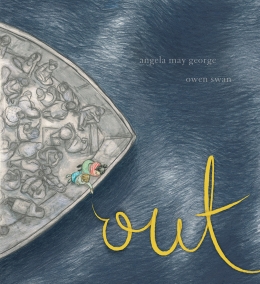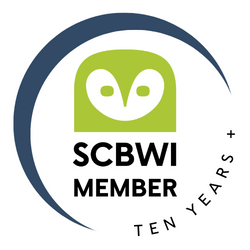As this post publishes, I’ll be in London, at the start of a six-day journey with my eldest daughter as she celebrates a new decade (yep! I’m old enough to have birthed a 30-year old!). Thinking about this trip has reminded me of other journeys I’ve undertaken with one or more of my children, including a few rather lengthy rail journeys, several Atlantic crossings, and even a boat journey or two.
Today’s Perfect Picture Book begins with a mother-daughter journey – a journey to a new life, away from a war-torn country. This is the type of journey most of us will never take, but that we must understand, as we welcome new immigrants to our communities.
 Title: Out
Title: Out
Written By: Angela May George
Illustrated By: Owen Swan
Publisher/date: Scholastic Canada Ltd./2017 (originally published by Scholastic Australia/2016)
Suitable for Ages: 4-8 (and older)
Themes/Topics: refugees; asylum; journeys; family
Opening:
I feel different. It’s the way people stare. I’m called an asylum seeker, but that’s not my name.
Brief Synopsis: A young girl describes her journey fleeing a war-torn region and settling into life in a new country.
Links to Resources:
- Check out the Teaching Guides for Grades 2-3 and Grades 4-5;
- What do you think a new child or family may need if they leave their homeland and move to your town or city?
- The narrator of this story travels by boat to her new home. Have you ever taken a boat journey? Draw a picture or describe in words the boat and where you traveled;
- The narrator and her mother play a string game (cat’s cradle) while on their journey. What games do you think you could play with a new child at school who may not speak English?
Why I Like this Book:
In Out, George and Swan provide a sympathetic portrayal of the flight and resettlement of a nameless girl and her mother in a new, nameless, safe city and country. While readers learn why the pair leave their homeland, a war, and accompany them on a long boat journey to the new country, much of the story is an upbeat, hope-filled account of their resettlement experiences.
I think Out will resonate with children who are refugees, and it could help their classmates understand the refugees’ experiences. At one point, the narrator thinks back on the boat ride that “seems so long ago,” and notes that “these days” she runs to “win races” and camps “for fun.” She then explains, though, that “some days, when there’s a loud bang, I drop to the floor.” If a classmate reacts to loud noises or perhaps draws pictures of what s/he has seen, the other kids, and even some teachers, may understand the reason for what otherwise may seem like strange behavior after reading and discussing Out. They then may be better able to support their classmate/student.
Swan’s mix of felt-tipped marker and colored pencil illustrations are, in his words, “rough-around-the-edges” to convey the sense of the roughness and uncertainty of a refugee’s life.
A Note about Craft:
Like several other refugee stories I’ve reviewed recently, George utilizes first-person point of view to draw us into the story, become emotionally connected to the narrator and experience the life of a refugee through her eyes. This is particularly effective when, in the opening scene, the narrator informs us that she is called an “asylum seeker,” but that isn’t her name. I immediately wanted to hug her and call her by name!
Especially as she recounts the narrator’s flight to the new country, George tackles some difficult issues such as war, fear, hunger and thirst. Rather than dwell on them, George instead refers to “horrible things” that show the narrator “what it is to be brave.” When she hears noises at night, she listens to the river, that “knew the way out of the forest.” When hungry, mother and daughter “whispered our favourite foods to each other.” None of these examples, in my mind, minimizes the traumatic events. In each instance, however, the narrator and reader move on and find solace in something, thereby offering hope.
Swan weaves a yellow string through the story that ties the narrator’s former life to her new life. Younger children, in particular, may find comfort in the string as hair bow in an early spread, a game on the long boat journey, and a tie on her backpack towards story’s end. What threads can we, as authors or illustrators, use to show the connections in our stories?
See an author’s note and illustrator’s note in Study Notes that accompanied the first Australian printing.
Visit Owen Swan’s website to learn more about this Australian illustrator.
This Perfect Picture Book entry is being added to Susanna Hill’s Perfect Picture Books list. Check out the other great picture books featured there!







Wow! This is a wonderful book to share with children who have made this long journey and for students in schools. Our church is going to be a sanctuary church and take in refugees in the near future. This book and others you have share would be great to read to the children at church to help them understand!
LikeLiked by 1 person
And I think because it’s Scholastic, you can find it here. That’s wonderful that your church will be a sanctuary church.
LikeLiked by 1 person
What a powerful cover! Thanks for sharing.
LikeLiked by 1 person
There’s a double spread with the mother & daughter on the boat that’s very powerful, too.
LikeLiked by 1 person
Thank you for sharing this one, Patricia. It sounds like a moving and important story. And I love how the cover works!
LikeLiked by 1 person
Thanks, Gabi. I think Out will help start some important conversations & build empathy for refugees.
LikeLiked by 1 person
Sounds like a great book! When I was teaching we’d often have kids from far away countries join our school community. This would be the perfect book to read the class!
LikeLiked by 1 person
Agreed! I hope you can read Out together.
LikeLike
I love this refugee series you are doing. This one seems to have several layers and great depth to it.
LikeLiked by 1 person
Very perceptive & well written, Joanna. Out does have several layers & would be great for classroom discussion.
LikeLike
Powerful story. Thanks for introducing it to us.
LikeLiked by 1 person
Hope you can find it in your local library.
LikeLike
A story for our time. Thank you for sharing it.
LikeLike